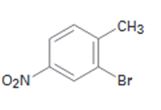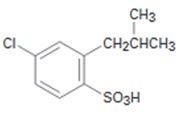
Concept explainers
a)

Interpretation:
Starting from benzene and assuming that the ortho and para isomers can be separated how the compound can be synthesized is to be shown.
Concept introduction:
The compound required is 2-bromo-4-nitrotoluene. Benzene can be converted into alkyl benzene by Friedal-Crafts alkylation. The alkylbenzene can be nitrated in the ortho and para positions as the alkyl groups are ortho and para directors. Nitro group is deactivating while alkyl group is activating in nature. Hence bromonation of the nitrotoluene will introduce the bromine in the ortho position to alkyl group.
To show:
Starting from benzene and assuming that the ortho and para isomers can be separated how 2-bromo-4-nitrotoluene can be synthesized.
b)

Interpretation:
Starting from benzene and assuming that the ortho and para isomers can be separated how the compound can be synthesized is to be shown.
Concept introduction:
The Friedal-Crafts acylation of benzene will yield an acyl benzene as the product. Chlorination of the acyl benzene will produce m-chloroacyl benzene as the acyl group is meta directing. Reduction of the acyl group to the corresponding alkyl group and sulfonation of the product will result in the product required.
To show:
Starting from benzene and assuming that the ortho and para isomers can be separated how the compound can be synthesized.
Trending nowThis is a popular solution!

Chapter 16 Solutions
Organic Chemistry
- Which of the following molecules could be considered aromatic? Assume all of the compounds are planar. ^ N H₂ Cyclopentadiene is especially acidic for a hydrocarbon. Use a diagram to explain why.arrow_forward13. How could you synthesize the following compound from butadiene and ethylene? Harrow_forwardHaloalkanes undergo nucleophilic substitution whereas haloarenes undergo electrophilic substitution. Explain.arrow_forward
- When cyclopropane is treated with HI, 1-iodopropane is formed. A similar type of reaction does not occur with cyclopentane or cyclohexane. Suggest an explanation for cyclopropane’s reactivity.arrow_forwardHow can alkenes and alkynes be classified: as nucleophiles, as electrophiles or depending on the reaction conditions could be both? Explain extensively.arrow_forwarda) What products would you expect from the elimination reaction of 3-Bromo-2- methylpentane? Show the reaction by writing the condensed structural formula of the reactants and products. Identify the major and minor products. b) What alkyl halide might the 3,6-Dimethyl-1- heptene have been made from?arrow_forward
- Draw structures for the 8 constitutional isomers with the molecular formula C,H,2 that contain a benzene ring.arrow_forward1) Draw the structures of the following compounds from the a) 5,6,7R-trimethyl-2E,5Z-nonadiene b) 4R-ethyl-3S-methylcyclohexene.arrow_forwardQuestion: Describe the concept of "aromaticity" as it pertains to organic chemistry. How does the concept of aromaticity explain the unusual stability of benzene, and how does it apply to heterocyclic compounds?arrow_forward
 Chemistry for Today: General, Organic, and Bioche...ChemistryISBN:9781305960060Author:Spencer L. Seager, Michael R. Slabaugh, Maren S. HansenPublisher:Cengage Learning
Chemistry for Today: General, Organic, and Bioche...ChemistryISBN:9781305960060Author:Spencer L. Seager, Michael R. Slabaugh, Maren S. HansenPublisher:Cengage Learning
